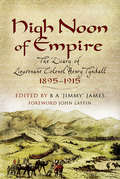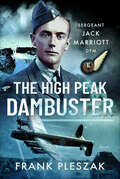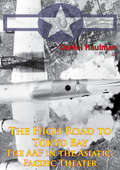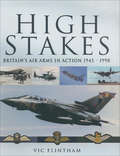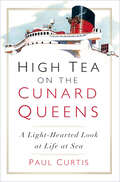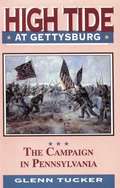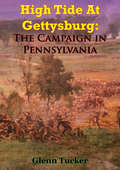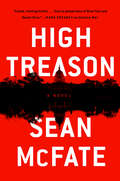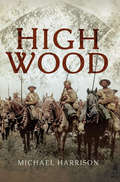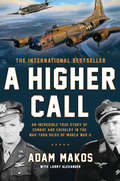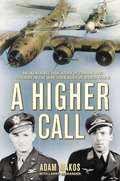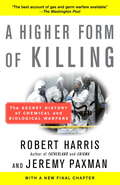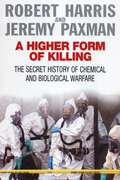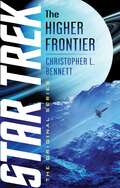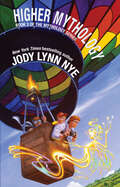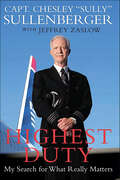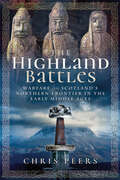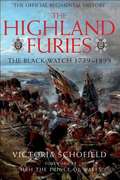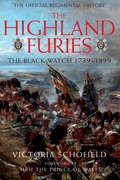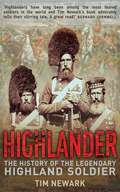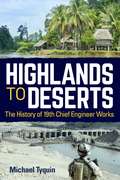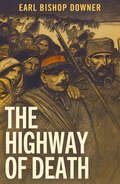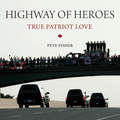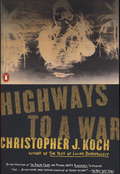- Table View
- List View
High Noon of Empire: The Diary of Lieutenant Colonel Henry Tyndall, 1895–1915
by B A James"Henry Tyndall was a typical product of the Victorian age—an intensely patriotic army officer who served in India, on the North-West Frontier, on the Western Front and in East Africa at the height of the British empire. For 20 years, from 1895 to 1915, he kept a detailed diary that gives a vivid insight into his daily life and concerns, his fellow officers and men, and the British army of his day. He also left a graphic account of his experiences on campaign in the First World War and in the Third Afghan War. B.A. 'Jimmy' James has edited and annotated Tyndall's diary in order to make it fully accessible to the modern reader. As he notes in his introduction, 'this marching soldier of the queen was a gallant officer who conscientiously served his sovereign wherever duty called ... his diary deserves attention as it reflects the manners, customs and attitudes of this vanished age.' "
The High Peak Dambuster: Sergeant Jack Marriott DFM
by Frank PleszakOperation Chastise, the audacious attack on the dams in the Ruhr valley, is arguably one of the most famous airborne attacks in history. During the night of 16/17 May 1943, 133 men in nineteen specially-adapted Lancasters – the famous Dambusters – set off to attack six dams deep in the heart of Germany. Eight of the bombers, and 56 of the aircrew, did not come home. Three of the aircrew who took part were from the High Peak region of Derbyshire. Flight Lieutenant Bill Astell, the pilot of ED864 who hailed from Coombs near Chapel-en-le-Frith, was killed after flying into electricity pylons on the way to the dams. The navigator in ED924, Sergeant John Nugent, from Stoney Middleton, survived the Dambusters Raid but was killed later in the war. The third High Peak Dambuster, on whom this biography concentrates, is the little-known Sergeant Jack Marriott from Chinley, the flight engineer on Lancaster ED937 during the attack. Marriott’s Lancaster, Z-Zebra, reached the Möhne Dam, only to discover that it had been breached, some five bouncing bombs already having been released at it. The crew, led by Squadron Leader Henry Maudslay DFC, then flew on to the Eder Dam where their ‘bouncing bomb’ exploded beneath the Lancaster after hitting the parapet of the structure. The damaged Lancaster struggled homeward, but was shot down on the Dutch border; Jack, together with his crew, was killed in the crash. In this autobiography, Frank Pleszak explores Jack’s life, his RAF service prior to joining 617 Squadron, and then the events leading up to and during Operation Chastise itself. But for Jack, one the immortal Dambusters, his story continued on after that historic night – particularly during the filming of the 1955 epic Dam Busters in which his aircraft features.
The High Road To Tokyo Bay — The AAF In The Asiatic-Pacific Theater [Illustrated Edition]
by Daniel HaulmanIncludes over 10 photos and mapsIn early 1942, Japanese military forces dominated a significant portion of the earth’s surface, stretching from the Indian Ocean to the Bering Sea and from Manchuria to the Coral Sea. Just three years later, Japan surrendered, having lost most of its vast domain. Coordinated action by Allied air, naval, and ground forces attained the victory. Air power, both land-and carrier-based, played a dominant role.Understanding the Army Air Forces’ role in the Asiatic-Pacific theater requires examining the context of Allied strategy, American air and naval operations, and ground campaigns. Without the surface conquests by soldiers and sailors, AAF fliers would have lacked bases close enough to enemy targets for effective raids. Yet, without Allied air power, these surface victories would have been impossible.The High Road to Tokyo Bay concentrates on the Army Air Forces’ tactical operations in Asia and the Pacific areas during World War II. A subsequent pamphlet will cover the strategic bombardment of Japan.
High-Speed Marine Craft
by Mantle Peter J.This book details the efforts to build a large naval vessel capable of traveling at one hundred knots. It is the first book to summarize this extensive work from historical and technical perspectives. It explores the unique principles and challenges in the design of high-speed marine craft. This volume explores different hull form concepts, requiring an understanding of the four forces affecting the lift and the drag of the craft. The four forces covered are hydrostatic (buoyancy), hydro-dynamic, aerostatic, and aerodynamic. This text will appeal to naval researchers, architects, graduate students and historians, as well as others generally interested in naval architecture and propulsion.
High Stakes: Britain's Air Arms in Action, 1945–1990
by Vic FlinthamAfter the dust of World War II had settled, the military position of the UK was far from straightforward. It was of course allied to the USA and part of NATO, but it was at odds with the former in maintaining an Empire and the two nations also had competing oil interests in the Middle East. The UK's engagement in war after 1945 was thus a strange mixture ranging from homeland security through insular actions within the colonies or protectorates to preserve empire - to playing a major role in confronting the USSR. The types of active involvement of the RAF, Fleet Air Arm and Army Air Corps between 1945 and 1995 include the following, with examples.Maintaining Local Stability - Greece, Netherlands East Indies. Maintaining Empire - Malaya, Kenya. Defending Empire - Borneo. Defending Interests - Suez, Kuwait. Homeland Security - Northern Ireland, air defence. Confrontation - Berlin Airlift, Korea. Covert Action - Albania, strategic reconnaissance. Humanitarian and Peacekeeping- Jordan, Cyprus. Development of Deterrent - Bombs, bombers and missiles.
High Tea on the Cunard Queens: A Light-Hearted Look at Life at Sea
by Paul CurtisThis amusing insight into Cunard’s legendary liners begins more than fifty years ago when the author joined the original Queen Mary as an entertainments officer, when a part of the job was ‘bumbling’ the passengers while keeping a wary eye out for professional gamblers criss-crossing the Atlantic, and there was bingo and dance bands, novelty dancing and fancy-dress parades, and a primitive disco with a monster juke box. Paul Curtis recounts the stories of the ships, the antics of passengers and crews, and much more besides. Just turning these pages releases a sniff of the sea and a whiff of champagne. This frank and funny account of mixes Cunard history with personal anecdote and vividly reveals how passenger and crew life have changed over the years across the Cunard liners.
High Tide at Gettysburg: The Campaign in Pennsylvania
by Glenn TuckerThe author tries to present how the Gettysburg battle was won and lost, and why the Gettysburg campaign remains such an appealing study to large numbers even after the passing of nearly a century.
High Tide At Gettysburg: The Campaign In Pennsylvania
by Glenn Tucker""Gettysburg had everything," Henry S. Commager recently wrote. "It was the greatest battle ever fought on our continent; it boasts more heroic chapters than any other one battle. It was the high tide of the Confederacy."This is the way Glenn Tucker has always seen it and this is the way he reports it in High Tide at Gettysburg. The story of Gettysburg has never been told better, perhaps never so well as in this volume. Glenn Tucker has the immediacy of a war correspondent on the spot along with the insights that come from painstaking research. The armies live again in his pages.In his big, generous book Glenn Tucker has room to follow Lee's army up from Chancellorsville across Maryland into Pennsylvania. With Jackson recently killed, Lee had revamped his top command.When Meade's men caught up with the Confederates and the two armies were probing to locate each other's concentrations, Mr. Tucker's account becomes sharper, more dramatic. His rapidly moving, vivid narrative of the three-day battle is filled with fascinating episodes and fresh, stimulating appraisals.Glenn Tucker is akin to Ernie Pyle in his interest in people. With him you meet Harry King Burgwyn, "boy colonel" of the 26th North Carolina, just turned twenty-one, who slugged it out with Col. Henry A. Morrow of the 24th Michigan until few survived on either side. You feel the patriotic surge of white-haired William Barksdale, who led his Mississippians on the "grandest charge of the war" and died as he broke the Federal line. You sense the magnetism of Hancock the Superb, and feel the driving power of rugged Uncle John Sedgwick as he hurried his big VI Corps to the battlefield. With Old Man Greene you struggle in the darkness to save the Culp's Hill trenches. And much more. Mr. Tucker weaves in many sharp thumbnail biographical sketches without slowing the action. Many North Carolinians, previously slighted, here receive their due.Full, dramatic, immediate, here is Gettysburg."
High Treason: A Novel (Tom Locke Series #3)
by Sean McFate“McFate just might be the next Tom Clancy, only I think he’s even better... The action is non-stop and shuttles back and forth between scary-believable and rollicking good fun. I read High Treason during a six-hour plane ride and the trip went by like the snap of my fingers.” —James PattersonIn this pulse-pounding action thriller perfect for fans of Brad Thor and David Baldacci, Tom Locke must stop dark forces working to overthrow the presidentEn route to the National Prayer Breakfast, the U.S. vice president’s motorcade is hit in a vicious, expertly planned attack that throws Washington, DC, into chaos. Everyone assumes it’s terrorists— everyone but young FBI agent Jennifer Lin. She is certain that the easy answers here are not the likely ones. . . . Half a world away, former military contractor Tom Locke has his own doubts about what happened—and who did it. He suspects his former employer, Apollo Outcomes. But why would the global private military corporation orchestrate such a brutal strike on U.S. soil?Returning to DC, Locke teams with Lin and discovers that a civil war is secretly brewing in the military-contracting world. A division of one company has gone rogue, led by a power-hungry former colleague of Locke’s who may have planned the attack on the vice president himself. But this man couldn’t have pulled it off without help from inside the government. The VP’s itinerary and route were confidential—which means there must be a traitor high up in either the White House or the NSA who is leaking information.But why? And who could be pulling the strings? Radical Islamic terrorists? Or is this a new ploy by Putin to subvert American leadership? Or is someone else behind the attack? Only Locke can get to the bottom of the conspiracy—and blow it apart with one bold strike before it’s too late.“High Treason has brutal assassinations, shocking betrayals, even heated gun battles in the shadow of the White House. It had me breathless—from the sheer audacity of its storytelling to its breakneck pacing. It’s not to be missed!” —James Rollins, #1 New York Times bestselling author of The Last Odyssey
High Wood
by Michael HarrisonBois de Fourcaux, a luxuriant woodland covering 75 acres, set in the area of the battlefields of the Somme, dominates the surrounding landscape today, as it did in the summer of the year 1916. Known to the British Army as High Wood, the invading Germans had occupied the wood as it proved to be a natural field fortification and a menace that had to be neutralized if the British were to find a way forward in their attempts to breach the trench systems of the German Army and break out into the Green Fields Beyond.This insightful publication will take the battlefield visitor, and also those who are unable to visit the site, on a journey through the history of the battles for High Wood and its environs. It covers the most significant dates in the British Armys struggle to eject the invader and the Germans determination to hold that which they considered to be their new National Frontier. This is the story of the largely amateur British Army of 1916. Lessons were learned in the roaring furnace of the Somme that would transform the fighting ability of the British irrevocably: High Wood was at the epicentre of that learning process.The book contains detailed maps from the time of the High Wood battles using the excellent British Trench maps and, importantly, an explanation on the use of the numbered grid system, which enables the visitor to locate, to within 5 yards, the site of an action that took place 100 years ago. Photographs are also included to enhance the visitor experience. Join us for the journey
A Higher Call: An Incredible True Story of Combat and Chivalry in the War-Torn Skies of World War II
by Adam Makos Larry AlexanderTHE NEW YORK TIMES AND INTERNATIONAL BESTSELLER Four days before Christmas 1943, a badly damaged American bomber struggled to fly over wartime Germany. At its controls was a 21-year-old pilot. Half his crew lay wounded or dead. It was their first mission. Suddenly, a sleek, dark shape pulled up on the bomber's tail--a German Messerschmitt fighter. Worse, the German pilot was an ace, a man able to destroy the American bomber in the squeeze of a trigger. What happened next would defy imagination and later be called the most incredible encounter between enemies in World War II. This is the true story of the two pilots whose lives collided in the skies that day--the American--2nd Lieutenant Charlie Brown, a former farm boy from West Virginia who came to captain a B-17--and the German--2nd Lieutenant Franz Stigler, a former airline pilot from Bavaria who sought to avoid fighting in World War II. A Higher Call follows both Charlie and Franz's harrowing missions. Charlie would face takeoffs in English fog over the flaming wreckage of his buddies' planes, flak bursts so close they would light his cockpit, and packs of enemy fighters that would circle his plane like sharks. Franz would face sandstorms in the desert, a crash alone at sea, and the spectacle of 1,000 bombers each with eleven guns, waiting for his attack. Ultimately, Charlie and Franz would stare across the frozen skies at one another. What happened between them, the American 8th Air Force would later classify as "top secret." It was an act that Franz could never mention or else face a firing squad. It was the encounter that would haunt both Charlie and Franz for forty years until, as old men, they would search for one another, a last mission that could change their lives forever.
A Higher Call: An Incredible True Story of Combat and Chivalry in the War-torn Skies of World War II
by Adam Makos Larry AlexanderFive days before Christmas 1943, a badly damaged American bomber struggled to fly over wartime Germany. At its controls was a twenty-one-year-old pilot. Half his crew lay wounded or dead. It was their first mission. Suddenly, a sleek, dark shape pulled up on the bomber's tail--a German Messerschmitt fighter. Worse, the German pilot was an ace, a man able to destroy the American bomber in the squeeze of a trigger. What happened next would defy imagination and later be called 'the most incredible encounter between enemies in World War II. ' This is the true story of the two pilots whose lives collided in the skies that day: the American--Second Lieutenant Charlie Brown, a former farm boy from West Virginia who came to captain a B-17--and the German--Second Lieutenant Franz Stigler, a former airline pilot from Bavaria who sought to avoid fighting in World War II. A Higher Call follows both Charlie and Franz's harrowing missions. Charlie would face takeoffs in English fog over the flaming wreckage of his buddies' planes, flak bursts so close they would light his cockpit, and packs of enemy fighters that would circle his plane like sharks. Franz would face sandstorms in the desert, a crash alone at sea, and the spectacle of 1,000 bombers each with eleven guns, waiting for his attack. Ultimately, Charlie and Franz would stare across the frozen skies at one another. What happened between them, the American 8th Air Force would later classify as 'top secret. ' It was an act that Franz could never mention or else face a firing squad. It was the encounter that would haunt both Charlie and Franz for forty years until, as old men, they would search for one another, a last mission that could change their lives forever.
A Higher Form of Killing: The Secret History Of Chemical And Biological Warfare
by Robert Harris Jeremy PaxmanA Higher Form of Killing opens with the first devastating battlefield use of lethal gas in World War I, and then investigates the stockpiling of biological weapons during World War II and in the decades afterward as well as the inhuman experiments conducted to test their effectiveness. This updated edition includes a new Introduction and a new final chapter exposing frightening developments in recent years, including the black market that emerged in chemical and biological weapons following the breakup of the Soviet Union, the acquisition of these weapons by various Third World states, the attempts of countries such as Iraq to build up arsenals, and--particularly and most recently--the use of these weapons in terrorist attacks.
A Higher Form of Killing
by Jeremy Paxman Robert HarrisThe secret story of chemical and biological warfare.A Higher Form of Killing was first published to great acclaim in 1982. The authors have written a new Introduction and a new Epilogue to take account of the events that have happened since the early 1980s - including the break-up of the former Soviet Union and the black market that appeared in chemical and biological weapons, the acquisition of these weapons by various Third World states, the attempts of various countries like Iraq to build up arsenals of these weapons and, most recently, the use of these weapons in terrorist attacks. As the authors point out, the two generations since the Second World War lived with the threat of nuclear annihilation. Now a new generation must learn to live with weapons that are more insidious and potentially more devastating.
The Higher Frontier (Star Trek: The Original Series)
by Christopher L. BennettAn all-new Star Trek movie-era adventure featuring James T. Kirk! Investigating the massacre of a telepathic minority, Captain James T. Kirk and the crew of the U.S.S. Enterprise confront a terrifying new threat: faceless, armored hunters whose extradimensional technology makes them seemingly unstoppable. Kirk must team with the powerful telepath Miranda Jones and the enigmatic Medusans to take on these merciless killers in an epic battle that will reveal the true faces of both enemy and ally!
Higher Mythology (Mythology)
by Jody Lynn NyeHoll, Keith Doyle&’s best friend, has finally tied the knot with his beloved, Maura in the Little Folks&’ new home, Hollow Tree Farm. Keith has good news of his own: he has started on an internship as a copywriter with a Chicago advertising agency, coming up with slogans and designs for new products, but the project he is really enthusiastic over is chasing air sprites in a hot air balloon. Unfortunately, one of the agency&’s client businesses is using the Little Folks&’ land as a dump for toxic waste. Holl&’s young cousin Dola sees them do it, but they see her, too. To prevent anyone else from finding out, then men kidnap her and Holl and Maura&’s new baby, Asrai. All of the Little Folk are called in to hunt for them. Keith reaches out to the new and wonderful air creatures he&’s found in hopes of bringing the baby and her brave guardian back to the farm.
Highest Duty: My Search for What Really Matters
by Chesley B. Sullenberger Jeffrey ZaslowNow a major motion picture from Clint Eastwood, starring Tom Hanks—the inspirational autobiography by one of the most captivating American heroes of our time, Capt. ‘Sully’ Sullenberger—the pilot who miraculously landed a crippled US Airways Flight 1549 in New York’s Hudson River, saving the lives of all 155 passengers and crew.On January 15, 2009, the world witnessed a remarkable emergency landing when Captain "Sully" Sullenberger skillfully glided US Airways Flight 1549 onto the Hudson River, saving the lives of all 155 passengers and crew. His cool actions not only averted tragedy but made him a hero and an inspiration worldwide. His story is now a major motion picture from director / producer Clint Eastwood and stars Tom Hanks, Laura Linney and Aaron Eckhart.Sully's story is one of dedication, hope, and preparedness, revealing the important lessons he learned through his life, in his military service, and in his work as an airline pilot. It reminds us all that, even in these days of conflict, tragedy and uncertainty, there are values still worth fighting for—that life's challenges can be met if we're ready for them.
The Highland Battles: Warfare on Scotland's Northern Frontier in the Early Middle Ages
by Chris PeersThis in-depth history of medieval Scottish warfare highlights the rivalries between the Norse warlords and the early Scottish kings.Between the ninth and fourteenth centuries, Scotland’s northern and western highlands underwent a turbulent period of significant wars. The Highlands and islands were controlled by the kings of Norway or by Norse or Norse-Celtic warlords, who not only resisted Scottish royal authority but on occasion seemed likely to overthrow it.In The Highland Battles, Chris Peers provides a coherent and vivid account of the campaigns and battles that shaped Scotland. The narrative is structured around a number of battles—Skitten Moor, Torfness, Tankerness, Renfrew, Mam Garvia, Clairdon and Dalrigh—which illustrate phases of the conflict and reveal the strategies and tactics of the rival chieftains.Peers explores the international background to many of these conflicts which had consequences for Scotland’s relations with England, Ireland and continental Europe. He also considers to what extent the fighting methods of the time survived into the post-medieval period.
The Highland Furies
by Victoria SchofieldAs the oldest of the Highland Regiments, The Black Watch has an enviable roster of Battle Honours and a mystique born of repeated service on behalf of King, Queen and country. On the strength of her acclaimed biography of Field Marshal Earl Wavell, the regimental trustees commissioned Victoria Schofield to write this, the first volume of her magisterial history of the The Black Watch, and have fully cooperated with her as she traces the story of the Regiment from its early 18th-century beginnings through to the eve of the South African War at the end of the 19th-century. Originating as companies of highland men raised to keep a 'watch' over the Highlands of Scotland, they were formed into a regiment in 1739. Its soldiers would go on to fight with extraordinary bravery and élan in almost every major engagement fought by the British Army during this period, from the American War of Independence, the Peninsular Wars, Waterloo, the Crimea, Indian Mutiny to Egypt and the Sudan. Drawing on diaries, letters and memoirs, Victoria Schofield skilfully weaves the multiple strands of this story into an epic narrative of a valiant body of officers and men over one-and-a-half centuries. In her sure hands, the story of The Black Watch is no arid recitation of campaigns, dates and battle honours, but is instead a rich and compelling record of the soldier's experience under fire and on campaign. It is also a celebration of the deeds of a regiment that has played a unique role in British history and a vivid insight into the lives of the many remarkable figures who have marched and fought so proudly under its Colours.
Highland Furies: The Black Watch 1739-1899
by Victoria SchofieldAs the oldest of the Highland Regiments, The Black Watch has an enviable roster of Battle Honours and a mystique born of repeated service on behalf of King, Queen and country. On the strength of her acclaimed biography of Field Marshal Earl Wavell, the regimental trustees commissioned Victoria Schofield to write this, the first volume of her magisterial history of the The Black Watch, and have fully cooperated with her as she traces the story of the Regiment from its early 18th-century beginnings through to the eve of the South African War at the end of the 19th-century. Originating as companies of highland men raised to keep a 'watch' over the Highlands of Scotland, they were formed into a regiment in 1739. Its soldiers would go on to fight with extraordinary bravery and élan in almost every major engagement fought by the British Army during this period, from the American War of Independence, the Peninsular Wars, Waterloo, the Crimea, Indian Mutiny to Egypt and the Sudan. Drawing on diaries, letters and memoirs, Victoria Schofield skilfully weaves the multiple strands of this story into an epic narrative of a valiant body of officers and men over one-and-a-half centuries. In her sure hands, the story of The Black Watch is no arid recitation of campaigns, dates and battle honours, but is instead a rich and compelling record of the soldier's experience under fire and on campaign. It is also a celebration of the deeds of a regiment that has played a unique role in British history and a vivid insight into the lives of the many remarkable figures who have marched and fought so proudly under its Colours.
Highlander: The History of the Legendary Highland Soldier
by Tim NewarkAcclaimed historian Tim Newark tells the story of the Highlanders through the words of the soldiers themselves, from diaries, letters, and journals uncovered from archives in Scotland and around the world. At the Battle of Quebec in 1759, only a few years after their defeat at Culloden, the 78th Highlanders faced down the French guns and turned the battle. At Waterloo, High- landers memorably fought alongside the Scots Greys against Napoleon’s feared Old Guard. In the Crimea, the thin red line stood firm against the charging Russian Hussars and saved the day at Balaclava. Yet this story is also one of betrayal. At Quebec, General Wolfe remarked that, despite the Highlanders’ courage, it was "no great mischief if they fall.” At Dunkirk in May 1940, the 51st Regiment was left to defend the SOE evacuation at St Valery; though following D-Day, the Highlanders were at the forefront of the fighting through France. It is all history, now: Over the last decade the historic regiments have been dismantled, despite widespread protest.Skyhorse Publishing, as well as our Arcade imprint, are proud to publish a broad range of books for readers interested in history--books about World War II, the Third Reich, Hitler and his henchmen, the JFK assassination, conspiracies, the American Civil War, the American Revolution, gladiators, Vikings, ancient Rome, medieval times, the old West, and much more. While not every title we publish becomes a New York Times bestseller or a national bestseller, we are committed to books on subjects that are sometimes overlooked and to authors whose work might not otherwise find a home.
Highlands to Deserts: The History of 19th Chief Engineer Works
by Dr. Michael TyquinHighlands to Deserts is the story of a small Australian Army engineering unit determined to use more than bricks and bridges to make a difference, not only to Australian Army units but to indigenous communities both within Australia and overseas. The 19th Chief Engineer Works was raised in 1963 as the Army&’s premier engineering consultant, its purpose to plan, design and oversee the construction of barracks and training facilities in the New Guinea highlands. However the men of the unit demonstrated vision far beyond their limited brief, reaching into local communities and building relationships with tribesmen that were to prove strong and enduring. From the wilds of New Guinea, the unit extended its reach to the remote communities of outback Australia, designing infrastructure that reflected local needs. The engineers engaged with indigenous townships, cementing relationships as they planned essential infrastructure, their sole aim to make a difference to local lives. The unit&’s military remit ranged from designing bridges and wharfs to training facilities and even churches. The story of the 19th Chief Engineer Works, its people and its achievements, deserves to be far better known and Highlands to Deserts provides rich portrayals of the characters and the trials and tribulations that signpost their history. These are men and women who have invested in communities, large and small, near and far, seeking to improve the daily lives of soldiers and indigenous peoples. Having worked quietly in the background for 55 years, it is now time to tell the story of the 19th Chief Engineer Works.
The Highway of Death
by Earl Bishop DownerThe Highway of Death, first published in 1916, is the chilling account of the Austro-Hungarian invasion of Serbia (a tragic, largely forgotten aspect of the First World War) as viewed by American Red Cross surgeon Earl Bishop Downer. Based in Belgrade, he describes the bitter back-and-forth fighting for control of this capitol city, the devastating artillery barrages, the doctors and nurses trying to treat the endless stream of wounded combatants, and a typhus epidemic that ravaged soldiers and civilians alike. Included are 34 pages of illustrations.
Highway of Heroes: True Patriot Love
by Pete Fisher General W.J. NatynczykCanadians line the overpasses of the Highway of Heroes to show their support, grief, and pride in our fallen champions. The first four Canadian soldiers killed in Afghanistan were repatriated at Canadas largest military base in 2002. The fallen soldiers were driven down the 172-kilometre stretch of highway between Trenton and Toronto, and pedestrians lined the overpasses, hoping to make a connection with the grieving families. The support these people show isnt political; its not a movement for or against Canadian soldiers in Afghanistan. Its always been a grassroots movement about showing respect for our fallen champions. People young and old, emergency services workers, Canadian Legion members, military personnel, friends of the fallen, and family of fallen soldiers stand atop each bridge along the highway in the blistering heat or bone-chilling cold. After five years of this display of patriotism, the Highway of Heroes was officially named in the summer of 2007 and has been a gleaming example of a nation’s grief and its pride.
Highways to a War
by Christopher J. KochIn a riveting new novel of wartime Cambodia and Vietnam--part thriller, part mystery, part heroic epic--the author of The Year of Living Dangerously offers the story of a likeable, brave, but ultimately mysterious war photographer who has disappeared into the jungles of Cambodia.
